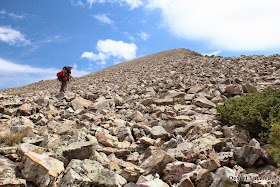To recap from a previous post, my husband and I climbed Pyramid Peak in Great Basin National Park last weekend. We started about 8,100 ft to reach the 11,926 foot summit. We chose to gain that 3,800 ft (more than climbing Wheeler Peak) by hiking near Dead Lake, which I covered in this last post.
Then we wanted to head over to the main Johnson Lake trail. On the topo map it looks quite easy, and the terrain wasn't too hard, with Engelmann spruce trees and patches of manzanita, but it sure felt long.
Eventually we reached the trail, where the going was a little easier. The trail must have had quite a rainstorm recently, because quite a few sections had sizeable gullies in them.
I was so happy to reach the Johnson Mill Historic Site, where we took a welcome break.
Then it was the very steep section up to the historic cabins near Johnson Lake. Imagining what it was like to be a miner is always fun--and intimidating. That could not have been an easy life.
After a quick snack and swimming break at the lake (it was warmer than expected), we took the steep trail up to the ridge.
This is a trail bighorn sheep would like--very steep and rocky!
As we reached the ridge, Pyramid Peak didn't look so far away.
There's no trail up to the top of Pyramid Peak, so we just made our way up the talus slope. As it got steeper, the peak looked farther away.
We kept hiking and hiking.
Johnson Lake looked very small below, so we knew we were making progress.
I busied my mind by searching for the beautiful alpine wildflowers, like these alpine fleabane (Erigeron leiomerus) and Holmgren's buckwheat (Eriogonum holmgrenii). I especially like the buckwheat, which only grows on the Snake Range.
Finally we made it to the top and got a photo to prove it (there's no register like in past years). In the background is the backside of Wheeler and Jeff Davis peaks. This view makes it a little more understandable why some of the early explorers thought the peak was volcanic, since it does somewhat resemble a crater. However, the rock is in fact quartzite. (Nevertheless, over 20% of the Great Basin is volcanic, a fun fact you can learn about more in my new book The Great Basin for Kids, available in the sidebar.)
From the top of Pyramid Peak you can see a bit of Baker Lake. It looks very small and by late summer a lot of the water has evaporated from it.

We also saw white butterflies chasing each other. They never landed so I couldn't get a photo of them, but this butterfly, I think a Great Basin Fritillary, did stop nearby.
I was also excited to see this Anise Swallowtail, my first viewing of this species.
Instead of going back the southwest ridge and retracing our steps by Johnson Lake, we decided to take the eastern ridge down, join the Shoshone Trail that goes over South Fork Baker Creek to the Johnson Lake trail, and then loop around. From the top it didn't look too bad (it never does, right?).
We saw some different plants on the eastern side, including this Purple-flowered Stonecrop (Rhodiola integrifolium). It contrasted nicely with the Erigeron.
As we descended, I really liked the view of Wheeler and Jeff Davis Peaks with their cloud shadows through the saddle of Pyramid and False Pyramid Peaks. I've hiked that saddle once, a pleasant hike. But then we decided to go down and meet up with the Baker Lake trail--not a good idea, the slopes are so steep that when you set a rock rolling, it just keeps rolling and rolling.
The clouds were building, so we were going down as fast as we could, but the descent was hard on our knees (mine still hurt a week later). We are definitely in monsoon season, with frequent afternoon thunderstorms.
A rock wren flitted on the rock in front of us.
Eventually we entered the trees, and before long the forest was so overgrown we could no longer follow the ridge. We dropped down on the Snake Creek side, bushwhacking through all sorts of vegetation. My favorite were the aspen groves, as they provided some shade and were a little easier to travel through.
Finally we made it back to camp, about seven hours after taking off. It was eight miles in total, but with our heavy packs, I don't think we could have gone much faster. We soaked our sore feet in the cold creek.
We packed up our camp before it started raining hard and paused to take a slightly blurry family photo. Thanks so much to our family and friends who watched the kids while we did the training hike. The kids certainly had a lot more fun with their cousins than they would have on that hike!
So in summary, Pyramid Peak is a beautiful peak to climb. If you climb it from the ridge between Johnson and Baker peaks, it's not too hard, but it still is a lot of elevation gain. Bushwhacking, as usual, makes a hike more difficult. But it's kind of fun seeing the less-traveled parts of the world! So I guess even though I was sore and tired after the hike, I will be doing more hikes.
























What an exciting day! And the view - Wow!!
ReplyDelete